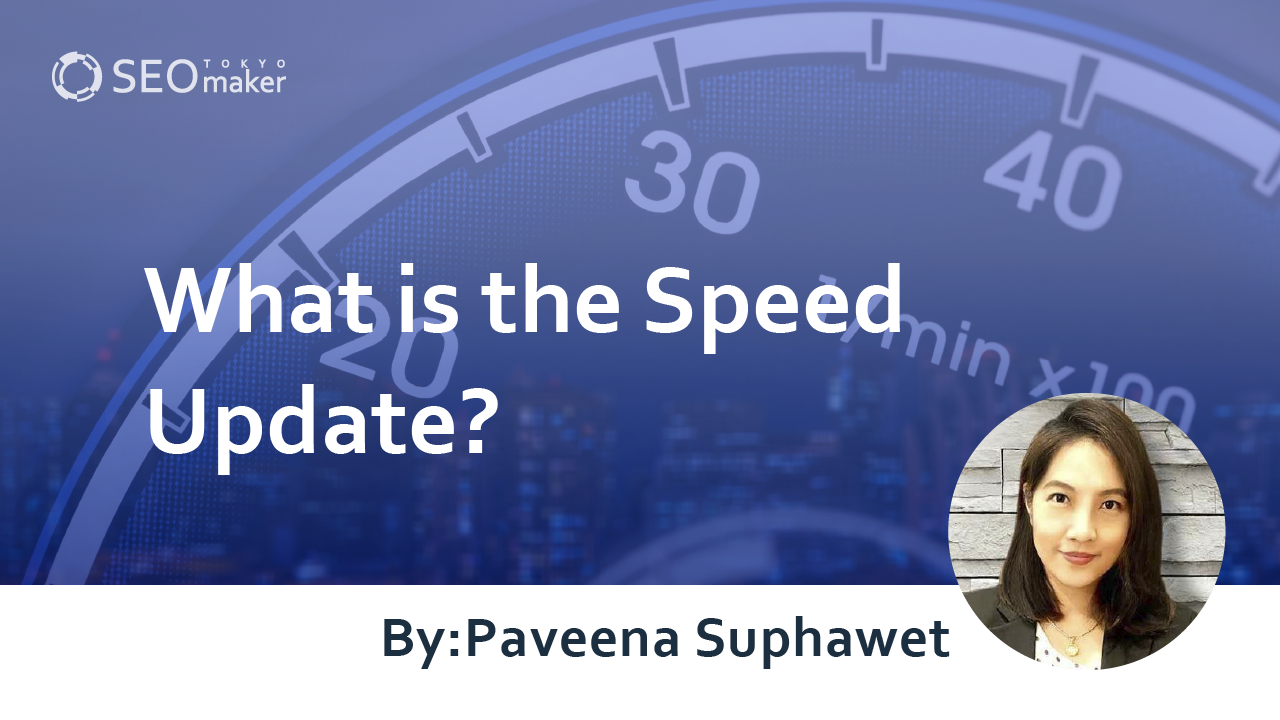What is the Speed Update? Explaining the Background and Target Media
contents

With the proliferation of mobile devices, smartphones and tablets have become essentials in modern society, significantly impacting our work and leisure activities.
Alongside these societal changes, Google’s search engine has evolved, particularly enhancing mobile searches to improve the overall user experience. This includes algorithm improvements known as the “Speed Update”.
Today, we’ll explain the Speed Update in an accessible way for beginners, as presented by Tokyo SEO Maker, a specialist SEO media.
What is The Speed Update?
The Speed Update, implemented in February 2018, was introduced to assess web page loading speeds on mobile search engines.
This update caused sites with extremely slow loading speeds to drop in search rankings.
However, faster loading speeds do not necessarily equate to higher rankings, making this update inconsequential for most websites.
Background of the Speed Update
This mobile search engine update was driven by the evolving digital age. Google has responded to each as follows.
- Implementing standards to assess site speed.
- Strengthening the mobile search engine.
- Incorporating speed criteria into the mobile search engine ratings.
1: Implementing Site Speed as an Evaluation Criterion
Google discovered through their research that search users are very concerned about website loading speeds. As a result, they implemented an update in 2010 that included website loading speed as an evaluation criterion.
At the time of the update, smartphones had not yet become widespread, so the Google search engine was not used on mobile devices. Therefore, the update targeted the desktop version of the Google search engine.
Reference: Using site speed in web search ranking
2.Mobile Search Engine Enhancement
As smartphones and tablets became widespread, the Ministry of Internal Affairs and Communications reports that smartphone household penetration in Japan grew from 9.7% in 2010 to 62.6% by 2013.
Source: Information and Communications White Paper
This led to increased usage of search engines on mobile devices, prompting Google to launch various measures to enhance the mobile search experience.
|
Timeline |
Updates |
|
December 2014 |
Venice Update |
|
April 2015 |
Mobile-Friendly Update |
|
September 2016 |
AMP Project |
As mobile devices continued to grow in prevalence, their use surpassed PCs in search engine queries, leading to the introduction of the July 2018 Speed Update.
Impact of the Speed Update
According to Google Search Central, this update is hypothesized to target websites and pages that meet the conditions outlined in the table below.
Targets websites for speed update
- Are mobile-oriented
- Take 3 seconds or more to load
- Contain irrelevant, low-quality content for the search query
Details are as follows.
-Pages taking longer than 3 seconds to load are considered slow
-High-quality pages are not penalized
A load time of more than 3 seconds is considered slow
The Speed Update primarily targets mobile websites and pages. Regarding the specifics of this update, Google states:
“The update only affects pages that are perceived as very slow by users and impacts only a small percentage of queries.
Source: Using page speed in mobile search ranking
However, what constitutes ‘very slow’ for users is not clearly defined, leaving the criteria somewhat ambiguous.
Meanwhile, it is said that if a page takes more than 3 seconds to load, 40% of visitors will abandon the site. This information, provided by a research firm, is cited by Google Search Central, lending it a degree of credibility.
“It’s not an exaggeration to say that 40% of people abandon sites that take more than 3 seconds to load.
Source: What is AMP
High-quality pages are not penalized
Google further states regarding the Speed Update.
“Search query intent remains a very strong ranking signal. Therefore, pages with highly relevant and excellent content may still rank well despite slow loading speeds.
Source: Using page speed in mobile search ranking
In other words, slow page loading speed does not necessarily result in a penalty.
Source: What is AMP
Enhancing Page Load Speed: To improve page load speeds, consider the following methods.
- Change servers.
- Simplify source code.
- Reduce the size of content data.
- Implement Lazy Load.
- Adopt AMP (Accelerated Mobile Pages).
Various data transfers occur between a site visitor’s device and the server before a webpage is displayed. Identifying which process is causing delays in page display speed is crucial. Start by pinpointing the cause and address it appropriately.
The content covered in this section is explained in detail on the page linked below. If you need specific measures, please refer to the page below.
Related article: How to Improve LPC
Changing Servers:
A server is the cloud-based location where website or page data is stored. Using an outdated server can cause performance issues and slow down page display speeds.
Besides just being old, other factors that can impact server performance include the following.
- Stored data is overwhelming the server capacity.
- The server is experiencing a surge in access requests.
Simplifying the Source Code
When visitors access a site, the web server processes the source code. Excessive unnecessary code can extend loading times.
If the source code is slowing down page display, it’s important to clean up and streamline the code.
Reducing Content Data Size
Loading text and image data, and rendering it on the visitor’s browser, can slow down page display speeds. Typically, images take up a significant portion of web page data. Focus on reducing the size of these image files.
Related article: 5 SEO Measures for Beginners / Image Optimization
Implementing Lazy Load
Lazy Load is a technique that delays the loading of certain images on a webpage.
Normally, when a web page opens, all data is loaded simultaneously. With Lazy Load, data is loaded in stages. For instance, there’s no need to load data below the fold immediately when a visitor first opens a page, so this data can be loaded later as needed.
Adopting AMP (Accelerated Mobile Pages)
AMP is a technology developed by Google to speed up mobile page displays. While it offers the benefit of faster page loading, there are drawbacks as follows.
-Potential disruption to site design
-Limited use of services and technologies
-Added complexity in page management.
Consider these factors to determine if AMP is right for your site.
Related Articles: What is AMP?
Tools for Measuring Page Display Speed
Several tools are available to measure web page display speeds as follow.
- PageSpeed Insights
- Google Analytics
- Lighthouse
- Google Search Console
PageSpeed Insights
PageSpeed Insights is a tool provided by Google for measuring page loading speeds.
Using this tool is simple. First, visit the tool’s page.
Tool URL: PageSpeed Insights
Enter the URL of the page you want to analyze into the form and click “Analyze.
After a short while, the results of the page speed analysis will be displayed.
Related Article: How to Measure and Improve Page Loading Speed with PageSpeed Insights
Lighthouse
Google Lighthouse is a tool for analyzing the performance of web pages.
This tool is an extension for Google Chrome, so it can be used if you are utilizing this browser.
Browser URL: Google Chrome
To install Google Lighthouse, navigate to the following page in Google Chrome.
Tool URL: Lighthouse
After installation, click the icon shown below on the page you want to measure.
Click “Generate report.
- Click ‘Generate report’
After some time, the measurement results will be displayed.
The “Speed Index” shown here corresponds to the page load time. The example image indicates areas for improvement.
Frequently Asked Questions About the Speed Update
Here are some frequently asked questions about the Speed Update in FAQ format.
Q: When was the Speed Update implemented?
A: The Speed Update was implemented in February 2018. At that time, the proliferation of mobile devices was continuing to grow, so Google launched this update to enhance the convenience of mobile searches by improving web page loading speeds.
Q: What is page display speed?
A: Page display speed refers to the time it takes from when a site visitor accesses a web page to when the page is displayed on the visitor’s device (browser).
Q: How else can page display speed be described?
A: It can also be referred to as page loading time.
In technical terms, it is known as LCP (Largest Contentful Paint).
Related Article: What is LCP?
Q: What causes slow page display speeds?
A: The causes are related to issues in the data transmission between the site visitor’s device and the server.
Specifically, there are following factors.
- Problems with the server
- Issues in the source code
- Large content data size
- Problems with the user’s device or network environment
Summary
The Speed Update is an update aimed at mobile searches. Initially, standards for site display speed were implemented for desktop search engines. This update reflects those existing standards in mobile searches as well. First, check if your site’s page display speed is adequate. If your page display speeds are slow, it might be uncomfortable for visitors, necessitating improvement works.










![What is a Description? Explaining the Meaning, Writing Style, and Changing Word Count – [2023 Edition]](https://www.switchitmaker2.com/en/wp-content/uploads/2024/09/what-is-description.webp)










